Discussions about expanding Long Beach’s Aquarium of the Pacific began in 2005, seven years after its doors were first opened, during a board of directors retreat.
“We all recognized that we needed to expand because our attendance was growing and the ability to deliver a good experience was being compromised,” Jerry Schubel, Aquarium president and CEO, said. “So, the question then became, ‘how do we expand?’ There was a very spirited debate that went on for some time.”
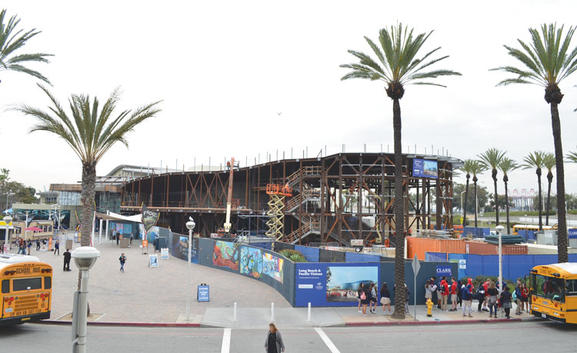
Construction on Pacific Visions, the Aquarium’s first major expansion since opening in 1998, is slated for completion in spring 2019. (March 8 Photograph by the Business Journal’s Pat Flynn)
The most common expansion for aquariums is constructing bigger tanks to house bigger animals, according to Schubel. Larger tanks and animals or adding swim-throughs that allow customers to snorkel with marine life were considered. Ultimately, it was decided the expansion should be an education-based space utilizing science and art to tell stories related to human impacts on the world’s oceans and marine life.
The result of this decision is the $53 million, 29,000-square-foot Pacific Visions wing currently under construction at the Aquarium. For the expansion, the board returned to San Francisco-based EHDD, the architecture firm that had designed the original Aquarium more than 20 years ago. Duncan Ballash, the firm’s president, said the initial design of the Aquarium was inspired by the ocean and made to resemble waves moving into Long Beach.
“With the new addition, it’s more of a deep ocean theme,” Ballash said. “Staying with the water metaphor, we came up with the biomorphic form that is a contrast to the existing [structure’s] form. What we are looking for is variability, depth and luminosity that is reminiscent of light passing over the deep ocean surface.”
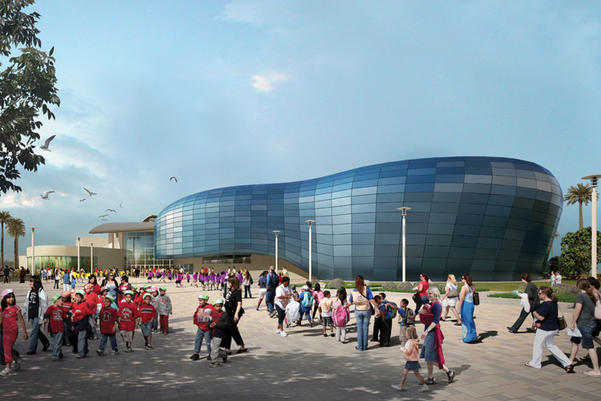
Pacific Visions’ design by San Francisco-based architecture firm EHDD includes 800 differently sized and angled glass panels to mimic light reflecting off the deep ocean. (Aquarium of the Pacific Rendering)
To achieve the deep-ocean effect, EHDD’s design utilizes 800 glass panels of various sizes placed at different angles to mimic the reflective qualities of the deep ocean. Reflected light will change based on time of day, clouds passing by and the position of the sun. In terms of building operations, Ballash said the mechanical system designs, such as lighting and water filtration, are energy efficient and environmentally friendly.
Pacific Visions will feature an art gallery, an orientation gallery, an immersive theater and a culmination gallery, which visitors will pass through in that order to gain the full experience of the stories being told. Ballash said this type of experience – live and interactive exhibits combined with multimedia platforms and art – is the future of aquariums, especially when it comes to highlighting larger species that aren’t appropriate to have in captivity.
“It starts with an art gallery, because our experience over the years is that often science isn’t the best way to engage the public,” Schubel said. “The idea in the orientation gallery is to make it clear to everyone that we all have a connection to the ocean no matter where we live. We want people to understand that the actions we take will determine the future we will live in.”
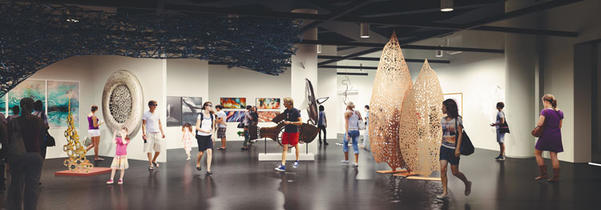
Upon entering the Pacific Visions wing, visitors will view an art gallery. (Aquarium of the Pacific Rendering)
Visitors will exit the orientation gallery and enter the 320-seat Honda Pacific Visions Theater. The immersive space will include a 32-foot-tall, 180-degree arc, 130-foot-long digital projection wall and a 30-foot diameter floor projection disc. The theater also will utilize mist, wind, scent and seat rumblers to bring audiences into the action of the content produced by Emmy Award-winning Cortina Productions.
According to Schubel, the film will be relatively short – about eight minutes – to keep the flow of visitors moving through the Pacific Visions experience. The storyline is still coming together, but Schubel explained that the film will give audiences two visions of the future: one that we are destined for if human impacts on oceans continue down their current path, and one of a “glorious future” in which people have taken steps to better care for the oceans and the life they contain.
Outside the theater, visitors will gather in the culmination gallery where they will make commitments as to how they will work toward ensuring a brighter future, Schubel explained. He said the gallery will include live animal exhibits, videos, interactives and a game related to improving Southern California’s water resilience.
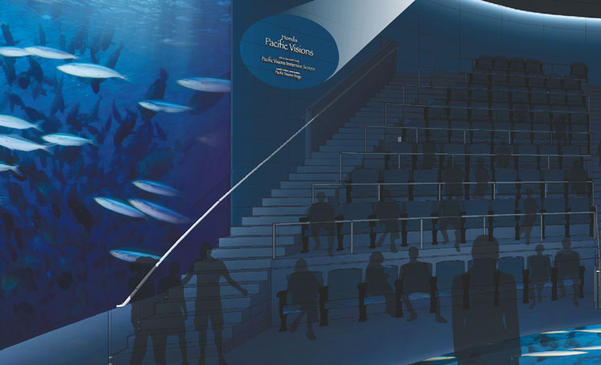
The 320-seat Honda Pacific Visions Theater includes a 32-foot-tall, 180-degree arc, 130-foot-long digital projection wall and a 30-foot diameter floor projection disc. The theater will show a short film and utilize mist, wind, scent and seat rumblers for an immersive experience. (Aquarium of the Pacific Rendering)
“I think it’s going to be very important for Long Beach. When we open Pacific Visions, we will be over two million visitors per year,” Schubel said. “It will be an architectural icon for the city. I think it will have a big and positive impact on Long Beach and that it will cast a very long shadow.”
Funding for the expansion is still between $2 million and $3 million shy of the $53 million needed. However, Schubel said proposals for additional funding are out for consideration and that he is confident funding will be secured to complete the expansion by the slated spring 2019 opening.
Funding has been accrued through a $15 million matching grant from the City of Long Beach, a $5 million matching grant from John, Michelle, Mario and Theresa Molina, $5 million from American Honda Motor Co. Inc., and $1 million-plus in donations from Dr. Allen and Charlotte Ginsburg, James and Marilyn Simons, the Don Temple Family Foundation, PREMIER/SMG and an anonymous donor. Dozens of other donations from corporations, foundations and individuals have been made to make the project possible.
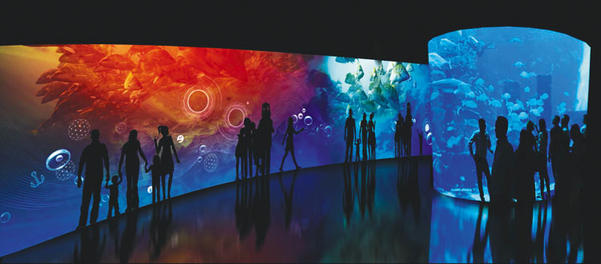
After exiting the Honda Pacific Visions Theater, visitors will enter a changing exhibit gallery, which will include live animals and an interactive digital wall. (Aquarium of the Pacific Rendering)
“It’s a pretty daunting task. [It is] unlike raising money for a children’s hospital because, you know, who doesn’t want to help the kids?” John Molina, a Long Beach resident and the outgoing chair of the Aquarium’s board, said. “So, I think we as boardmembers who have the capacity to donate should do so. My [family] and I put in [the matching grant] and we are happy to see that it has been met. We are very, very close to finishing up the funding for it.”
Molina said the expansion will attract more visitors to the city, increasing its prestige and creating jobs. The surge should put the Aquarium as one of the top five aquariums and museums in the country, according to Molina.
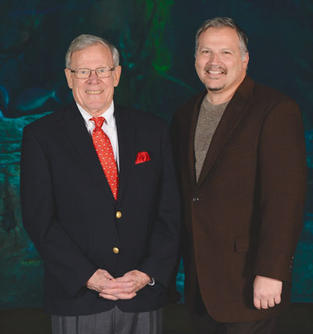
John Molina (right), pictured with Aquarium President and CEO Jerry Schubel, is the outgoing board president and a major donor to the Pacific Visions wing. Molina and his family offered a $5 million matching grant, which was met. (Photograph by Caught in the Moment Photography)
Those living in Southern California can’t help but concern themselves with climate change and rising sea levels, Molina said. This concern, coupled with the importance of the topic to future generations, was the reasoning behind what programming will be presented at Pacific Visions.
“When people think of an aquarium, they think of a bunch of fish tanks. They don’t think about art, they don’t think about telling stories,” Molina said. “So, it’s going to be the whole experience of walking into the art gallery, to being immersed in things in the theater and then coming out into the culmination gallery. It’s very well thought out and very exciting.”
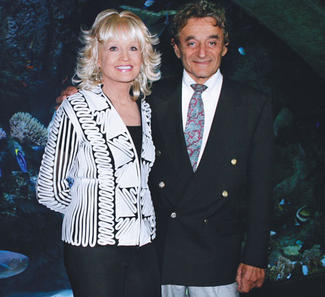
Dr. Allen and Charlotte Ginsburg.The Dr. Allen and Charlotte Ginsburg Foundation donated $1 million for the construction of the $53 million Pacific Visions expansion. In honor of the donation, the Aquarium’s main entrance has been named for the couple. (Aquarium of the Pacific Rendering) (Aquarium of the Pacific Photograph)
The Dr. Allen and Charlotte Ginsburg Member’s Entrance will welcome members into the Aquarium. Charlotte Ginsburg has been a boardmember for three years and the foundation has been actively involved with the Aquarium for 12 years.
More so than the physical expansion, Ginsburg said the partnership and collaboration within the community is her favorite aspect of the Pacific Visions project. She explained that, in addition to working with local artists for the art gallery, groups such as the Long Beach Symphony, Long Beach Opera and Long Beach Ballet will be able to bring their talents to the theater during special events for children and families to enjoy.
“It’s just another beautiful entertainment area to educate people about the oceans and the problems that we’re having. I believe they can be solved, but only if organizations like this get involved,” Charlotte said. “My husband and I are deeply committed to the world’s oceans and helping to preserve the planet. We’re just very excited to see it come together and it’s just a joy to be involved.”
